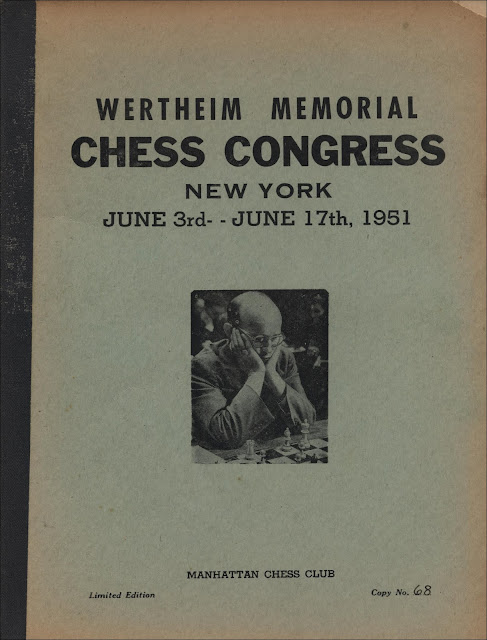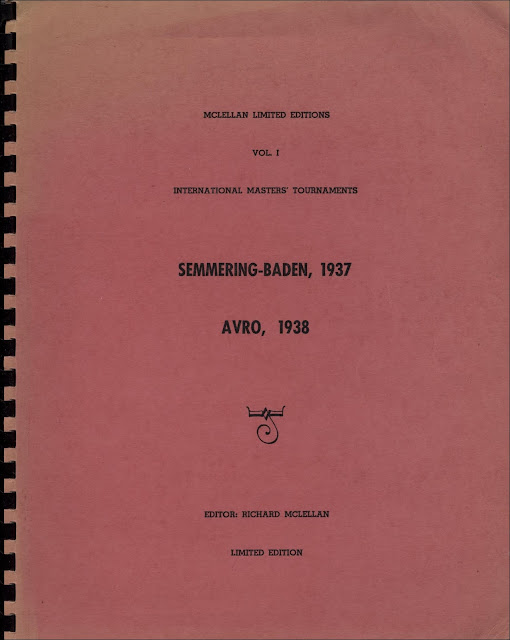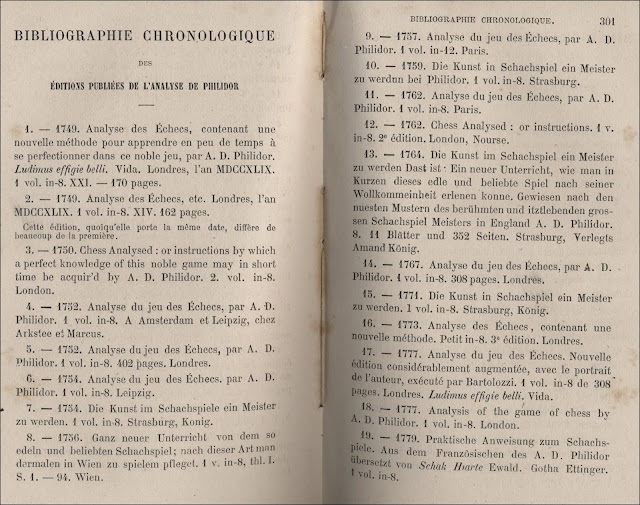Jack Spence, a lawyer from Omaha, Nebraska, USA, launched his series of limited editions in 1949, when in his early 20's, with a book on the 50th United States Open Championship which was held in his home town, and produced a total of 60 limited editions during the next 15 years.
These were mainly records of contemporary American tournaments but he also revisited major tournaments from the past, and his Foreign Tournament Series included several important events from the 1920's and 1930's such as Carlsbad 1923, Bad Kissingen 1928, San Remo 1930, etc. One of his aims was to present these tournament games for the first time in the English language.
These were mainly records of contemporary American tournaments but he also revisited major tournaments from the past, and his Foreign Tournament Series included several important events from the 1920's and 1930's such as Carlsbad 1923, Bad Kissingen 1928, San Remo 1930, etc. One of his aims was to present these tournament games for the first time in the English language.
The books were generally mimeographed, printed on rectos only, and bound in card covers with a plastic ring binding. The Supplements were simply stapled sheets without covers. Each copy was numbered. However, adverts for the Omaha 1949 book, which I have not seen, emphasise that it was press-printed and includes many photos.
These publications typically included a Preface and/or an Introduction giving details of the event covered and, occasionally, the source of the material, followed by cross-tables, brief but succinct round by round summaries, the games in descriptive notation (some books have light notes and comments, others do not), indices of games and openings, and usually a page of adverts for these limited editions.
Carlsbad 1923 also included a list of subscribers with 36 names:
In the Preface to Bad Nauheim 1935, Spence states that the source of his material was the acquisition of a number of unpublished chess tournament manuscripts from a Chicago collector, and in the Preface to New York 1933 this collector was revealed to be Paul Little, noted chess bibliophile of Chicago.
One of the smallest print runs was for his booklet on the United States Junior Chess Championship, Lincoln, 1955, with an issue of 75 copies, and I have already discussed this publication, along with United States Chess Championship, New York, 1957-1958, in a previous article on 6th February 2017, as these both featured Bobby Fischer.
After ending his series of limited editions in 1963, Jack Spence continued editing tournament booklets for Tony Gillam's The Chess Player series. One of these was a re-typed edition of his own book on the Wertheim Memorial Chess Congress held in New York in 1951, as most copies had been poorly printed with only a few being completely legible. (See Betts 25-206). Spence died in 1978 aged 52.
________________________________________________________________
Richard McLellan from Omaha, Nebraska, produced five limited editions from 1958 into the 1960's in a style very similar to Spence's productions, down to the same pink card covers and plastic ring binding. However, his books were simply a record of the game moves with absolutely no narrative or comments, not even forenames for the competitors.
McLellan, who had earlier assisted Jack Spence by translating German texts for some of his works, published his first limited edition in 1958, covering the tournaments at Semmering-Baden, 1937 and Amsterdam (AVRO), 1938. Semmering-Baden, 1937 had previously been the subject of Reinfeld's limited edition no. 7, published in 1938. Both of these tournaments were won by Paul Keres ahead of Reuben Fine, and they had four world champions behind them at Amsterdam.
All of McLellan's books covered European events from the 1930's and 1940's, including the match between Paul Keres and Max Euwe in 1939-1940 which had the smallest of his print runs with 120 copies.
________________________________________________________________
G. R. Stoney was a railroad timekeeper from, yes, you guessed it, Omaha, Nebraska, and he published his only limited edition in 1953 with a selection of games from the International Chess Tournament, Carslbad 1911. Only 100 copies were printed, mimeographed onto the rectos only and bound in pink card covers.
Stoney wrote an interesting two page Preface with details of the production of his "unassuming little volume", explaining that the games were compiled from various books, magazines and newspapers over a period of several years. He had particularly drawn from the Year-Book of Chess, 1912, by E. A. Michell. He recognised the difficulties encountered by Reinfeld, Cordingley and Spence in producing their own limited editions, and left open the possibility of producing further volumes.
The two page Introduction gives an overview of this very strong 25 round tournament, won by Teichmann ahead of Rubinstein and Schlechter with Marshall, Niemzowitsch, Alekhine, Spielmann etc. behind. There is also a list of the twelve brilliancy prize games. Most games have occasional notes and comments by Stoney. Game 31 is Marshall's 13 move miniature against Dus-Chotimirski.
More Limited Editions next time.
© Michael Clapham 2019
These publications typically included a Preface and/or an Introduction giving details of the event covered and, occasionally, the source of the material, followed by cross-tables, brief but succinct round by round summaries, the games in descriptive notation (some books have light notes and comments, others do not), indices of games and openings, and usually a page of adverts for these limited editions.
Carlsbad 1923 also included a list of subscribers with 36 names:
In the Preface to Bad Nauheim 1935, Spence states that the source of his material was the acquisition of a number of unpublished chess tournament manuscripts from a Chicago collector, and in the Preface to New York 1933 this collector was revealed to be Paul Little, noted chess bibliophile of Chicago.
One of the smallest print runs was for his booklet on the United States Junior Chess Championship, Lincoln, 1955, with an issue of 75 copies, and I have already discussed this publication, along with United States Chess Championship, New York, 1957-1958, in a previous article on 6th February 2017, as these both featured Bobby Fischer.
After ending his series of limited editions in 1963, Jack Spence continued editing tournament booklets for Tony Gillam's The Chess Player series. One of these was a re-typed edition of his own book on the Wertheim Memorial Chess Congress held in New York in 1951, as most copies had been poorly printed with only a few being completely legible. (See Betts 25-206). Spence died in 1978 aged 52.
 |
| Sample poorly printed page |
________________________________________________________________
Richard McLellan from Omaha, Nebraska, produced five limited editions from 1958 into the 1960's in a style very similar to Spence's productions, down to the same pink card covers and plastic ring binding. However, his books were simply a record of the game moves with absolutely no narrative or comments, not even forenames for the competitors.
McLellan, who had earlier assisted Jack Spence by translating German texts for some of his works, published his first limited edition in 1958, covering the tournaments at Semmering-Baden, 1937 and Amsterdam (AVRO), 1938. Semmering-Baden, 1937 had previously been the subject of Reinfeld's limited edition no. 7, published in 1938. Both of these tournaments were won by Paul Keres ahead of Reuben Fine, and they had four world champions behind them at Amsterdam.
All of McLellan's books covered European events from the 1930's and 1940's, including the match between Paul Keres and Max Euwe in 1939-1940 which had the smallest of his print runs with 120 copies.
________________________________________________________________
G. R. Stoney was a railroad timekeeper from, yes, you guessed it, Omaha, Nebraska, and he published his only limited edition in 1953 with a selection of games from the International Chess Tournament, Carslbad 1911. Only 100 copies were printed, mimeographed onto the rectos only and bound in pink card covers.
Stoney wrote an interesting two page Preface with details of the production of his "unassuming little volume", explaining that the games were compiled from various books, magazines and newspapers over a period of several years. He had particularly drawn from the Year-Book of Chess, 1912, by E. A. Michell. He recognised the difficulties encountered by Reinfeld, Cordingley and Spence in producing their own limited editions, and left open the possibility of producing further volumes.
The two page Introduction gives an overview of this very strong 25 round tournament, won by Teichmann ahead of Rubinstein and Schlechter with Marshall, Niemzowitsch, Alekhine, Spielmann etc. behind. There is also a list of the twelve brilliancy prize games. Most games have occasional notes and comments by Stoney. Game 31 is Marshall's 13 move miniature against Dus-Chotimirski.
More Limited Editions next time.
© Michael Clapham 2019



























